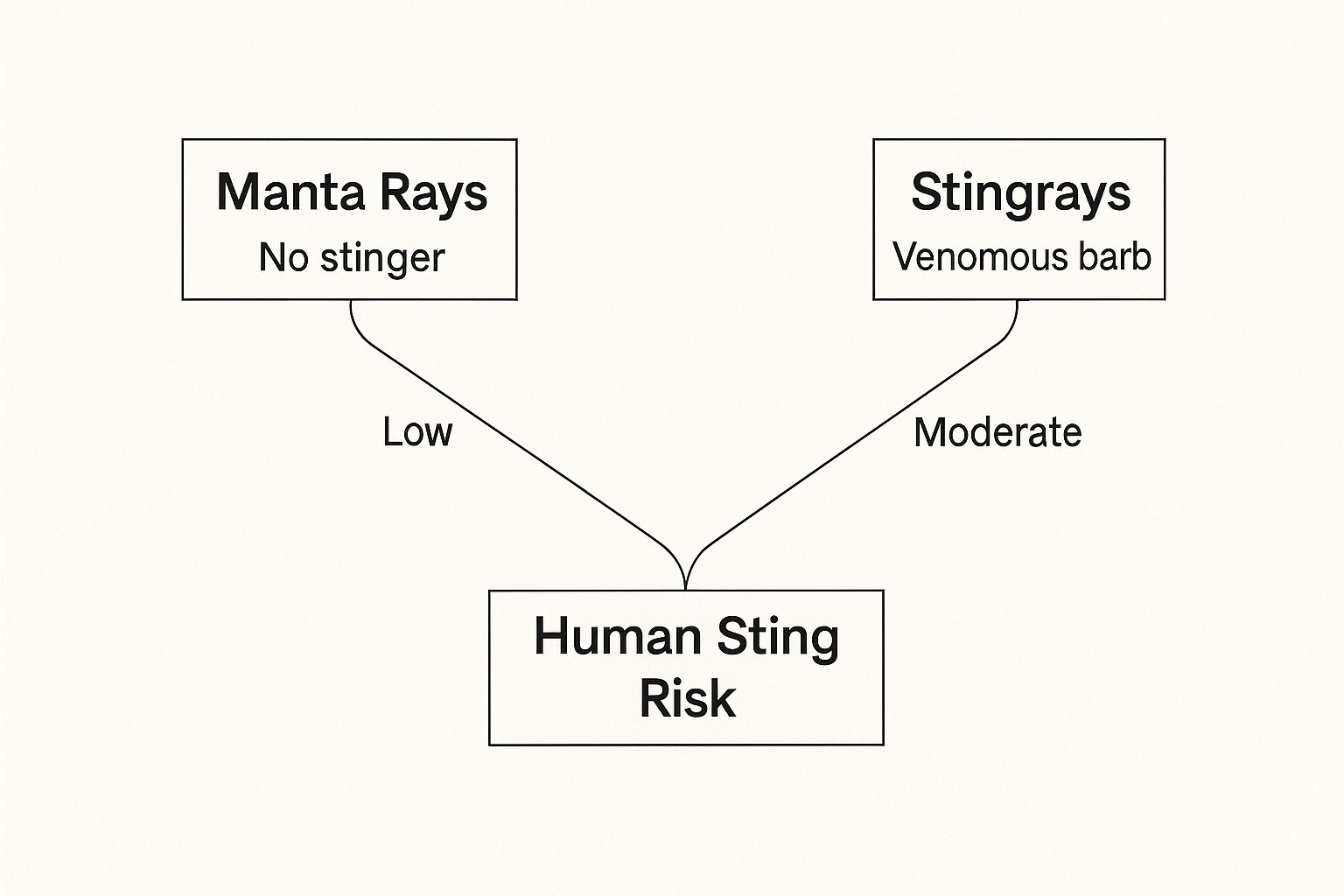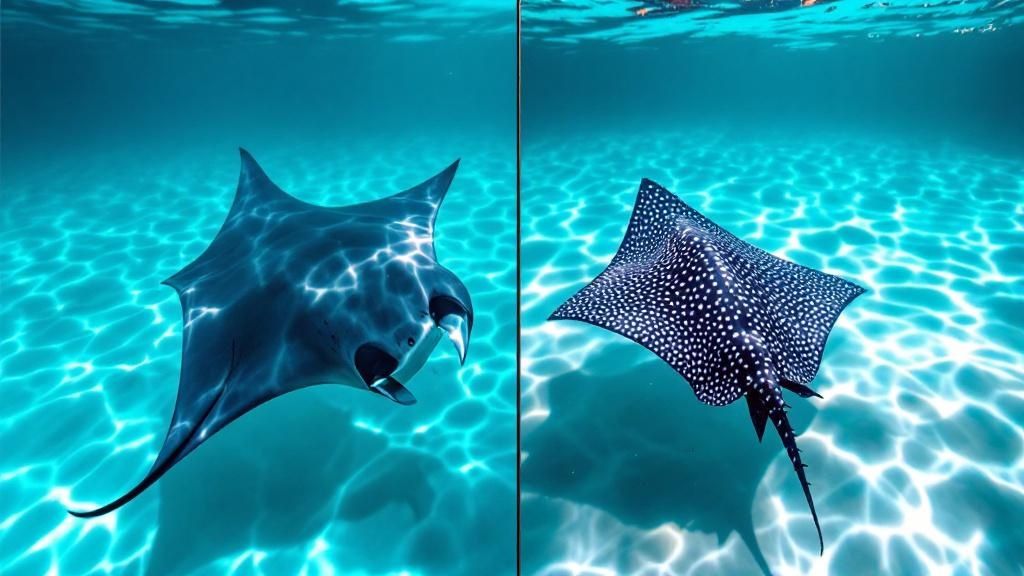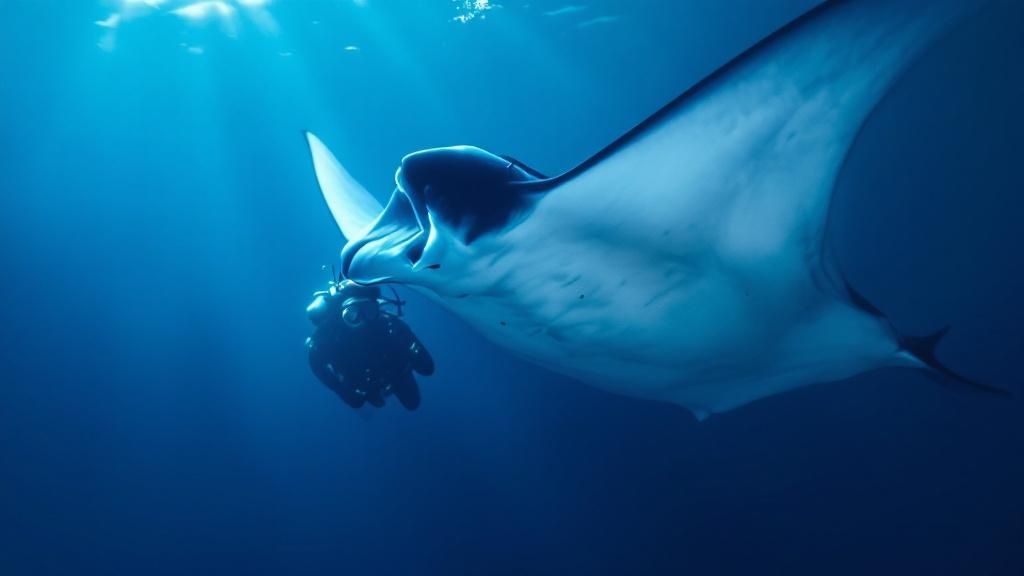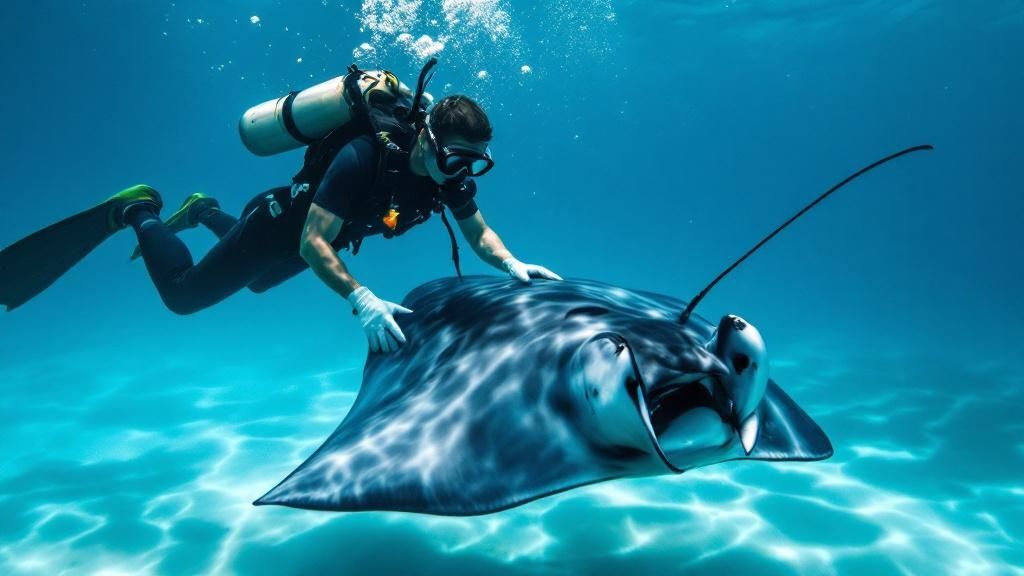Can Manta Rays Sting You? Find Out the Truth Today

Let's get right to the big question everyone asks: No, manta rays cannot sting you. It's a super common fear, and honestly, it makes sense. They look a lot like stingrays, but this is a classic case of mistaken identity. There's a good reason we call them the "gentle giants" of the ocean—they are completely harmless to people.
The Quick Answer to a Common Ocean Fear
Think of manta rays as the graceful, acrobatic gliders of the sea, not its hidden defenders. Their entire bodies and behaviors are designed for peaceful filter-feeding, not for fighting.
The confusion is totally understandable since they share a similar flat, winged body shape with their distant cousins, the stingrays. But that's where the similarities end. When you know what to look for, the differences are night and day. A manta ray is missing the one key piece of equipment that gives a stingray its name: a venomous tail barb. They have no stinger, no venom, and zero ability to sting.
The real difference comes down to how they defend themselves. Manta rays rely on their incredible size and speed to escape predators. Stingrays, on the other hand, use a sharp, venomous barb as a last-ditch weapon when they feel trapped or threatened.
This simple guide shows you everything you need to know about the risk—or lack thereof!

As you can see, the human sting risk from a manta ray is basically zero. They just aren't built for it. Getting this straight is the first step to swapping fear for fascination when you see these incredible animals in the water.
Manta Ray vs Stingray: A Tale of Two Tails
Sometimes seeing the differences side-by-side makes it all click. This quick table breaks down the key distinctions between these two related, but very different, animals.
| Feature | Manta Ray (Gentle Giant) | Stingray (Bottom Dweller) |
|---|---|---|
| Defense | Flees using size and speed | Uses a venomous tail barb |
| Tail | Long and smooth, no barb | Shorter, with a sharp stinger |
| Diet | Filter-feeds on tiny plankton | Hunts crustaceans on the seafloor |
| Habitat | Open ocean swimmer | Lives on or near the sandy bottom |
| Size | Can be massive (up to 29 feet!) | Typically much smaller |
Once you see them compared like this, it’s clear why one poses a potential (though rare) threat and the other is a peaceful giant you can admire without worry.
This crucial difference in their anatomy and lifestyle is why snorkeling with mantas is such a unique and safe experience. If you're excited to see these gentle giants for yourself, our ultimate guide to the Kona manta ray night snorkel has all the info you need to plan a safe and unforgettable adventure.
Why Manta Rays Are Built for Peace, Not Poison

To understand why manta rays are completely harmless, you just have to look at their anatomy and how they live. Evolution designed them perfectly for filter-feeding in the open ocean, not for fighting. They simply don't have the equipment to sting you. Their whole design is about graceful movement and eating efficiently, not self-defense.
The most obvious giveaway is the tail. Sure, it’s long and whip-like, but a manta ray’s tail is totally smooth. There’s no venomous barb or stinger anywhere on it. It’s used more like a rudder for steering than any kind of weapon. So, to the question "can manta rays sting you?" biology gives a clear answer—they are physically incapable of it.
This peaceful design carries right over to how they eat. Manta rays are basically giant, living vacuums of the sea.
Imagine a creature so perfectly designed for peace that its "horns" are actually just specialized fins for scooping up the tiniest of prey. This is the manta ray—a filter feeder, not a fighter.
Instead of hunting, they use two unique fins on their head called cephalic lobes. They unfurl these lobes to funnel massive amounts of water, packed with microscopic plankton, into their wide, forward-facing mouths.
A Body Built for Gliding, Not Stinging
A manta’s anatomy is the total opposite of a defensive bottom-dweller. Their entire body is built for a life in the open water, which is a huge reason why a safe encounter while swimming with manta rays is such a remarkable experience. Their powerful pectoral fins are made for "flying" through the water, not for hiding on the seabed.
Because they’re so focused on filter-feeding, they have zero biological need for a stinger. In fact, research consistently shows that the injuries we see on manta rays come from human activity, not from fighting each other. A 2022 study of over 4,900 reef mantas found that nearly 29% had injuries from boat strikes or fishing lines—but none from stinging, because they simply can't.
Understanding the Stingray and Its Defensive Barb

To really get why manta rays are so gentle, it helps to look at their infamous cousin: the stingray. Most of the fear surrounding mantas comes from a simple case of mistaken identity. People hear "ray" and immediately picture a stinger, but that's stingray territory, not a manta's.
Stingrays are bottom-dwellers. You'll find them masterfully camouflaged in the sand, where they hunt for crustaceans or hide from predators. Their key feature is the sharp, serrated barb on their tail. But it's not a weapon for hunting; it's a last-ditch defensive tool.
Think of a stingray’s barb like a bee's stinger. It's not something they use aggressively. They only deploy it out of pure self-defense when they feel trapped or threatened—like when an unsuspecting swimmer accidentally steps on one.
This reactive defense is the critical difference. A manta ray's first move is to bolt, using its incredible size and speed to escape. A cornered stingray, on the other hand, will use its barb to protect itself.
How a Stingray's Barb Works
The barb itself is a pretty wild piece of natural engineering. It's basically a modified dermal denticle (the same stuff that makes up shark skin) and is covered by a thin sheath of skin that packs a venomous punch. When a stingray strikes, the barb can cause a deep puncture wound while the venom delivers intense pain.
But even with this gnarly defense system, serious incidents are incredibly rare. While true stingrays are the ones with these venomous spines, and about 1,500 stings are reported in the U.S. each year, fatalities are almost unheard of. The tragic and highly-publicized death of Steve Irwin in 2006 was a true anomaly, caused by the barb striking his chest directly—a case of severe physical trauma, not just the venom. You can discover more details about stingray injuries and see just how uncommon these worst-case scenarios are.
Once you understand how a stingray operates, it throws the gentle nature of manta rays into sharp relief and helps put any lingering fears to rest. They're just two very different animals that happen to be related.
The Real Dangers in a Manta Ray Encounter

So we've established that manta rays can't sting you. But that doesn't mean an encounter is completely without risk—the thing is, the danger almost always flows from us to them, not the other way around. The biggest threats in any manta ray interaction are things we humans do, not the animals themselves.
For a snorkeler, the only remote risk you might face is an accidental bump. These gentle giants are huge, sometimes weighing over 3,000 pounds, and an unintentional collision during a close pass could certainly be startling. But they are incredibly graceful and aware of their surroundings, which makes this a very, very unlikely scenario.
The far more serious dangers are the ones we introduce into their world. When we understand our impact, we can shift from being just tourists to becoming true guardians of these incredible creatures.
The most pressing question isn't "Can manta rays sting you?" but rather, "How can we stop harming them?" Our actions, from the boats we drive to the trash we sometimes leave behind, have a direct and lasting impact on their survival.
Human Impact on Manta Ray Safety
The main threats that manta rays face are man-made, and almost all of them are preventable. This really puts the spotlight on why responsible marine tourism and conservation are so important.
-
Boat Strikes: Fast-moving boats can cause severe, often fatal, injuries. Manta rays love to feed near the surface, which unfortunately puts them right in the path of propellers and boat hulls.
-
Fishing Gear Entanglement: This is a huge one. Discarded or even active fishing lines and nets are a major threat. Mantas can get tangled up, leading to deep cuts, drowning, or even starvation if the gear prevents them from feeding properly.
Knowing these real dangers helps us approach every swim with the respect and care these animals deserve. One of the best ways to ensure a safe interaction for both you and the mantas is to go with a professionally guided tour.
For a truly magical and responsible experience, you should learn more about the manta ray night snorkel on the Big Island and how to observe these creatures in a way that helps protect them for years to come.
How to Swim with Manta Rays Safely and Responsibly
So, you know manta rays can't sting you—that's the first big step. But having a truly magical, up-close encounter means understanding the rules of engagement in their world. These gentle giants are incredibly curious and intelligent, and how we act in the water directly impacts their well-being.
Following a few simple guidelines is the key. It’s what separates a breathtaking experience from a stressful one, ensuring the encounter is amazing for you and completely harmless for them.
The single most important rule is to never, ever touch a manta ray. Their skin is coated in a special mucus layer, which is their first line of defense against nasty bacteria and parasites in the ocean. When we touch them, even with the best intentions, we wipe off that protective slime. It’s like stripping away their immune system, leaving them vulnerable to serious skin infections.
The Dos and Don'ts of Manta Encounters
To have a respectful interaction, your goal is to become a passive observer. Think of yourself as part of the scenery. Float calmly and let the mantas take the lead. Any sudden movements, splashing, or trying to chase them will only spook them, ruining the moment for everyone.
- Do: Stay calm and float horizontally on the surface. This makes you seem much less intimidating and gives the mantas space to comfortably swim above and below you.
- Don't: Chase or swim directly at a manta ray. Let them decide if they want to approach you. Their curiosity will often bring them close if you're patient.
- Do: Keep a respectful distance. A good rule of thumb is to stay at least 10 feet away, but don't be surprised if they close that gap themselves!
- Don't: Use flash photography. The sudden, bright bursts of light can easily disorient and startle the mantas, especially on a night snorkel when they're focused on feeding.
The core principle is simple: be a log, not a linebacker. Float peacefully and let the magic unfold around you. The less you do, the more you’ll see, as the mantas will feel safe enough to continue their beautiful, acrobatic feeding dance.
Becoming a Responsible Manta Ambassador
Following these rules isn't just about protecting the animals in that moment; it makes you a steward for the ocean. When you show respectful behavior, you help preserve these incredible encounters for many years and many people to come.
Going out with a certified, responsible guide is one of the best ways to make sure you're in good hands. For anyone planning this bucket-list experience, a comprehensive guide to the Manta Ray Night Dive in Kailua Kona offers some fantastic tips to prepare.
Ultimately, a successful swim is one where the mantas are left completely undisturbed by our presence. You can learn more about getting ready for this incredible adventure by reading about snorkeling with manta rays. Your mindful approach helps ensure these magnificent creatures continue to grace our waters for generations.
Your Manta Ray Questions Answered
Even after we've gone over the key differences, it's totally normal to have a few more questions rattling around. When you're thinking about sharing the water with an animal that can weigh more than a car, you want all the details you can get. This is where we clear up those last-minute curiosities and "what if" scenarios.
Think of this as your final briefing before hopping in the water for an adventure you'll never forget.
What Should I Do If a Manta Ray Swims Directly at Me?
The short answer? Absolutely nothing.
Just stay calm, float, and be still. When a manta swims right for you, it's not being aggressive—it's just being curious. These are incredibly smart animals, and they're constantly checking out their surroundings, which includes you. The last thing you want to do is start flailing or kicking. Just hold your position horizontally in the water and get ready for a breathtakingly close view as it effortlessly glides around you. It's a truly magical moment that many snorkelers only dream of.
The best encounters happen when you become part of the scenery. By remaining still, you signal to the manta that you are not a threat, allowing it to continue its beautiful, ballet-like feeding dance completely undisturbed.
Are Any Other Rays Besides Stingrays Dangerous?
Yes, but it's crucial to know the difference. Many other rays that belong to the same group as stingrays (Myliobatiformes) do have a defensive stinger. Out in the ocean, you might see:
- Eagle Rays: They often look like they're "flying" through the water just like mantas, but they have a venomous barb at the base of their tail.
- Bat Rays: These are common along the Pacific coast and carry a sharp stinger for defense.
- Cownose Rays: You'll often see these migrating in massive schools, and they also have a defensive tail barb.
But here's the key takeaway: the world's two largest ray species—the manta ray and the closely related devil ray—are both completely harmless filter feeders. They have no stinger at all, which sets them worlds apart from their armed relatives. Our guide covering manta ray FAQs goes into even more detail on how to tell these amazing animals apart.
Why Is Touching a Manta Ray So Harmful?
Touching a manta ray strips off its protective mucus coating. This slimy layer is basically its immune system, shielding it from all the nasty bacteria and parasites in the ocean.
When you touch them, you wipe that protection away, leaving the manta vulnerable to dangerous skin infections and disease. The rule is simple and absolute: look, but never touch.
At Kona Snorkel Trips, we're all about creating incredible memories while protecting Hawaii's precious marine life. Join us for an adventure you'll never forget by booking your snorkel tour at https://konasnorkeltrips.com.
